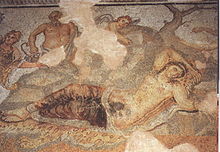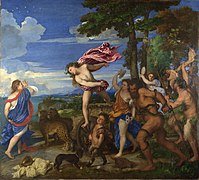Ariadne
Ariadne ( Greek Ἀριάδνη 'the holiest', Latin and others Ariadna , Italian Arianna ) was the daughter of the Cretan king Minos and his wife Pasiphaë , a daughter of the sun god Helios , in Greek mythology . She helped Theseus defeat the Minotaur . Later she became the bride of the wine god Dionysus .
On Crete she was also considered the goddess of fertility . In this capacity she was also venerated in Naxos , Delos , Cyprus and Athens .
myth
The myth of Ariadne has been spread in different versions since the Homeric period.
Ariadne and Theseus in Crete
Ariadne's siblings were Glaukos , Phaidra , Akakallis , Androgeos , Deukalion and Katreus . Her half-brother on her mother's side was the bloodthirsty hybrid Minotauros (a bull-headed man), who arose from a relationship between the Pasiphaë and a bull and was imprisoned in Crete in a labyrinth built by the inventor and architect Daedalus .
The Athenian version of the legend tells that Minos had conquered Athens after his son Androgeus was murdered there. The Athenians were obliged to send seven virgins and seven young men to Crete every nine years as human sacrifices for the Minotaur. When the hideous tribute was due for the third time , the Athenian prince Theseus smuggled into the group of the damned. Arrived in Crete, Ariadne fell in love with Theseus at first sight and agreed to help him defeat the Minotaur against his marriage promise. When Theseus entered the labyrinth in which Minotaur lived, she gave him, on Daedalus' advice, a ball of woolen thread, the end of which he attached to the entrance to the labyrinth. Theseus killed the monster and, thanks to Ariadne's thread , found his way out of the labyrinth unharmed.
Ariadne on Naxos

Theseus then fled towards Athens, accompanied by Ariadnes. The story is vaguely, sometimes even contradicting, continued in the various versions. The oldest mention in the Odyssey makes it - at least according to some interpreters - fall victim to the jealousy of the goddess Artemis . According to later versions, Ariadne was already intended for the wine god Dionysus by a higher power and a wedding between her and Theseus was therefore not allowed to take place at all. Other narrators portrayed Theseus' marriage vows as insincere. In any case, Ariadne is left behind on a stopover on the island of Naxos. Hesiod and most of the other narrators report that she was found completely abandoned and sleeping on the beach on the island of Dionysus. The wine god fell in love with her and chose her to be his bride. He tossed her diadem high into the sky, where it became the constellation of the Northern Crown . Dionysus and Ariadne had several sons, including Oenopion , who embodies wine making (→ oenology ), and Thoas .
Despite her connection with Dionysus, Ariadne remained in love with Theseus and weeped bitterly about his death. Nevertheless, after her death, Dionysus brought Ariadne from Tartarus to his home on Olympus .
Artistic representations
Ariadne has been featured widely in literature, the visual arts, and music. A popular motif is the triumph of Bacchus .
Visual arts
painting
Titian : Bacchus and Ariadne , 1520–1523
Jacopo Tintoretto : Bacchus and Ariadne , 1576
Annibale Carracci : Triumphal procession of Bacchus and Ariadne, 1597
John Vanderlyn , Ariadne Sleeping on Naxos , 1808–1812
Hans Makart , The Triumph of Ariadne , 1873/74
Evelyn de Morgan : Ariadne in Naxos , 1877
- Sebastiano Ricci : Bacchus and Ariadne, 1700–1710
- Evelyn de Morgan : Ariadne in Naxos, 1877
- Maurice Denis : Bacchus and Ariadne, 1907
- Giorgio de Chirico : The Awakening Ariadne, 1913
- Lovis Corinth : Ariadne on Naxos, 1913
- Michael Triegel : Sleeping Ariadne, 2010
sculpture
- Johann Heinrich Dannecker : Ariadne on the Panther, 1803
music
The Ariadne material was first set to music by Claudio Monteverdi in 1608 as the opera L'Arianna , of which, however, only the Lamento d'Arianna has survived. The following works have also survived:
Operas
- Johann Georg Conradi : The beautiful and faithful Ariadne, 1691
- Benedetto Marcello : Arianna, 1726
- Nicola Antonio Porpora Arianna e Teseo, 1714 (in Vienna); Arianna in Nasso, 1733 (in London)
- Georg Friedrich Handel : Arianna in Creta , 1733 (in London; one month after Porpora)
- Georg Anton Benda : Ariadne on Naxos , 1789
- Joseph Haydn : Arianna a Naxos (cantata for soprano and accompaniment), 1789
- Richard Strauss : Ariadne on Naxos , 1912
- Bohuslav Martinů : Ariane , 1958
- Wolfgang Rihm : Aria / Ariadne, 2001
- Harrison Birtwistle : Minotaur, 2008
ballet
- Albert Roussel : Bacchus et Ariane, 1930
Instrumental music
- Pietro Locatelli : Il Pianto d'Arianna, Concerto grosso Op. 7 No. 6, 1741
Ariadne as namesake
Among other things, the asteroid (43) Ariadne and a series of space rockets of the ESA named after Ariadne. A political crime series for women was also published under the name Ariadne .
See also
literature
- Magnus Frisch: Ariadne - a woman between hero and god. In: The ancient language teaching. 56, No. 4-5, 2013, ISSN 0002-6670 , pp. 26-37.
- Vinciane Pirenne-Delforge: Ariadne. In: The New Pauly . Encyclopedia of Antiquity . Volume 1. Metzler, Stuttgart / Weimar 1996, ISBN 3-476-01471-1 , Sp. 1075-1077.
- Renate Schlesier : Ariadne. In: Maria Moog-Grünewald (Ed.): Mythenrezeption. The ancient mythology in literature, music and art from the beginnings to the present (= Der Neue Pauly . Supplements. Volume 5). Metzler, Stuttgart / Weimar 2008, ISBN 978-3-476-02032-1 , pp. 140-150.
- Heinrich Wilhelm Stoll : Ariadne . In: Wilhelm Heinrich Roscher (Hrsg.): Detailed lexicon of Greek and Roman mythology . Volume 1,1, Leipzig 1886, Sp. 540-546 ( digitized version ).
- Richard Wagner : Ariadne 1 . In: Paulys Realencyclopadie der classischen Antiquity Science (RE). Volume II, 1, Stuttgart 1895, Col. 803-810.
- Lutz Walther (ed.): Ancient myths and their reception. A lexicon. Reclam, Leipzig 2003, ISBN 978-3-379-20051-6 .
University publications
- Silke Köhn: Ariadne on Naxos. Reception and history of motifs from antiquity to 1600 (= art studies , volume 3), Utz, Munich 1999, ISBN 3-89675-660-5 (dissertation, FU Berlin 1996, 281, [83] pages with illustrations and graphic representations, 21 cm ).
- Nikolaos-Ioannis Koskinas: " Strange I moved in, stranger I move out again", from Kassandra , via Medea , to Ariadne: Manifestations of the psyche in Christa Wolf's latest work (= Epistemata / Series Literary Studies , Volume 629), Königshausen & Neumann, Würzburg 2008, ISBN 978-3-8260-3756-6 (dissertation HU Berlin 2008, 246 pages, 24 cm).
- Jörg Maurer: Investigations into the poetic technique and the models of the Ariadne epistle Ovids , Lang, Frankfurt am Main / Bern / New York, NY / Paris 1990, ISBN 3-631-42596-1 (Dissertation University of Heidelberg 1989, 187 pages, 21 cm).
- Claudia Marie Wolf: Ariadne sleeping in the Vatican: a Hellenistic type of statue and its reception (= Antiquitates series , Volume 22), Kovač, Hamburg 2002, ISBN 3-8300-0632-2 (dissertation University of Munich 1999, XXXIII, 371, 106 pages with illustrations, 21 cm).
Web links
Individual evidence
- ↑ Libraries of Apollodorus 3,1,2,4
- ↑ Libraries of Apollodor 3,1,4,2
- ↑ Robert von Ranke-Graves: Greek Mythology. Sources and Interpretation. 7th edition. Vol. 1, Rowohlt, Reinbek 1974, ISBN 3-499-55113-6 , plate 9, above and p. 275.
- ↑ Diodor , Library 4.61; Plutarch , Theseus 19; Hyginus , Fabulae 42; Robert von Ranke-Graves: Greek Mythology. Pp. 305-308
- ↑ Homer , Odyssey 11, 321-325
- ↑ Hesiod, Theogony 947-949
- ↑ Ovid , Metamorphoses 8.169 to 182.







